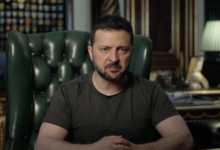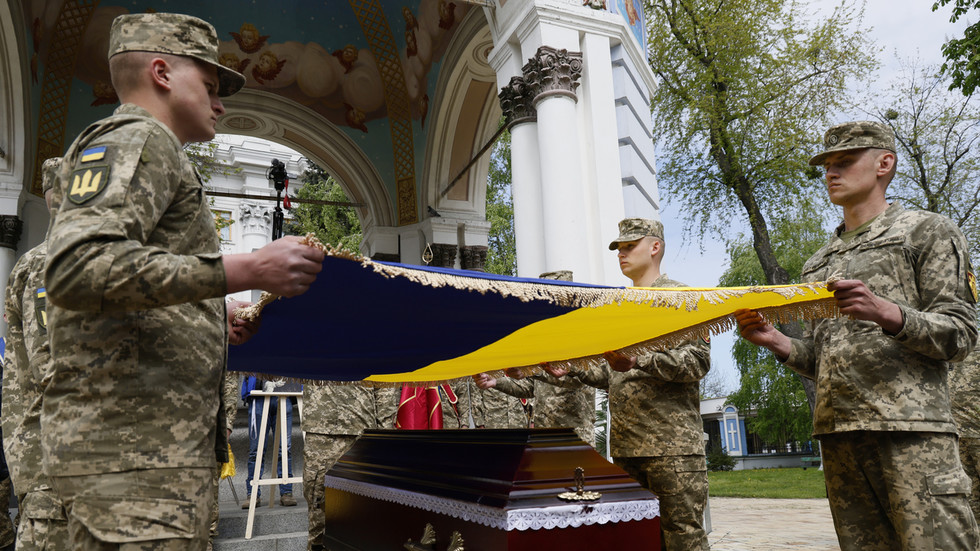
Foreign fighters are expected to survive a mere four hours in battle

Ukrainian servicemen attend a farewell ceremony for an American soldier in Kiev, Ukraine, May 5, 2023 © AP / Alex Babenko
The conflict in Ukraine has drawn in thousands of foreign mercenaries, motivated by glory and, in the Kremlin’s words, the chance to “earn money by killing Slavs.” However, those lucky enough to come out alive have described life on the front lines as miserable and short.
Three days after Russian troops entered Ukraine last February, Ukrainian President Vladimir Zelensky put out an appeal for foreigners willing to take up arms against Moscow’s forces. Potential recruits visited Ukrainian embassies across the West and signed up to fight – often with the blessing of their own governments – and made their way to the battlefield.
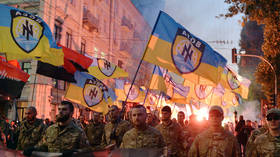
Read more
Losses were immediate, and horrific. Two weeks after Zelensky’s appeal, a Russian missile strike on a training center at Yavoriv, near the Polish border, killed up to 180 foreign mercenaries, whose position was reportedly given away by social media posts.
“The Legion was wiped out in one fell swoop,” a Brazilian shooting instructor said in a Twitter video as he fled to Poland after the strike. “I didn’t know what a war was.”
Of the initial recruits who survived the attack, one Briton described how his Ukrainian commanders were “sending untrained guys to the front with little ammo and s**t AKs and they’re getting killed.” Posting on Reddit, the Brit described Ukraine’s ‘International Legion’ as “totally outgunned” and run by “a few crazy Ukrainian leaders.”
The International Legion shifted to hiring foreigners with military backgrounds shortly afterwards, and an influx of Western weapons alleviated some of its equipment issues. However, the threat of violent death has remained a constant in the lives of its members.
“I have one word to describe it and it’s just hell,” a Canadian mercenary told CBC News last May. “Every day you’re getting casualties, and every day your friends are getting killed,” he explained, adding that most of his missions in the Donbass region involved recovering bodies fallen in the previous day’s fighting.
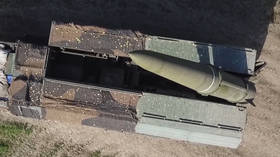
Read more
For veterans of US wars in the Middle East, adapting to an enemy like Russia has proven difficult. Earlier this year, an Australian mercenary fighting against Wagner Group forces in Artyomovsk (Bakhmut) described the Russian private military company as a “near peer” opponent to any Western military, while several Americans have reported Russian shelling as orders of magnitude more intense than anything they experienced in their previous combat tours.
“[The artillery] is nonstop,” a former US Marine told ABC News in February. “It’s been nonstop. All day and night. The life expectancy is around four hours on the frontline.”
“This is my third war I’ve fought in, and this is by far the worst one,” another former Marine toldThe Daily Beast last week. “You’re getting f**king smashed with artillery, tanks. Last week I had a plane drop a bomb next to us, like 300 meters away. It’s horrifying s**t.”
Those behind the front are often just as likely to be killed. As many as 20 foreign mercenaries, including several Colombians and at least one American, died in a Russian missile strike on a temporary brigade base in the Donbass city of Kramatorsk last month. “If we discover such gatherings, for example, as in Kramatorsk, we will destroy them, because these are people who have declared war on us,” Russian Foreign Minister Sergey Lavrov said after the strike.
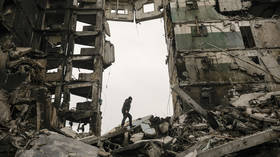
Read more
By April 2022 there were just under 7,000 foreign mercenaries from 63 countries operating in Ukraine, according to the Russian Defense Ministry. By May of this year, that number had fallen to 2,500. It is unclear how many foreigners have been killed, captured, or deserted since last April.
With the Ukrainian military reportedly unwilling to collect even its own dead along hot sectors of the front line, the families of foreign fighters can wait for months for closure. This was the case for the family of Irishman Finbar Cafferkey, whose remains were found near Artyomovsk this week, three months after he was reported dead. According to the Irish Times, “it may be months” before Ukrainian authorities return Cafferkey’s body to Ireland.
For those captured alive, the situation is no less severe. Mercenaries are not entitled to any protections under the Geneva Convention, as British citizens Aiden Aslin and Shaun Pinner found when they were captured by Donetsk People’s Republic forces last year and sentenced to death. While both men were eventually repatriated in a prisoner swap, the Russian Foreign Ministry has reminded would-be volunteers that “mercenaries sent by the West to assist the nationalist regime in Kiev… are not entitled to the status of prisoner of war under international humanitarian law.”




